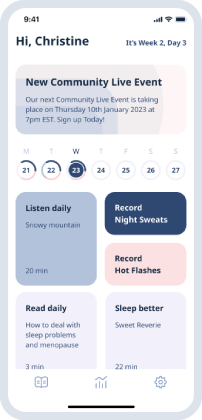
Discover the Magic of Hypnosis: How a Hypnosis Therapist Can Improve Your Life

Postmenopause Unveiled: Understanding and Managing the Change
Table of contents
- Autogenic Training: A Long-Established Relaxation Technique
- The Definition of Autogenic Training
- History of Autogenic Relaxation Techniques
- What is the Relationship between Hypnosis and Autogenic Therapy?
- Benefits and Uses of Autogenic Training
- Other Relaxation Techniques
- Tips for Making the Most of Your Practice
- Autogenic Therapy for Mental Health
- Autogenics Relaxation Techniques
- Clinical Outcome Studies: What Does Science Say about Autogenics?
- Is Autogenic Training Safe?
- Getting Started with UpNow Self-Hypnosis
Autogenic Training: A Long-Established Relaxation Technique
Autogenic training is a powerful relaxation technique used for decades to reduce stress, improve sleep, and increase overall well-being. It is a form of self-hypnosis aimed at relaxing the body and mind by focusing on particular sensations and images. With regular practice, autogenic training can help to reduce anxiety, increase mental clarity, and promote a sense of calm.
Ready to unlock the power of autogenic training? Keep reading to learn more about relaxation techniques, benefits and tips to help you get the most out of your practice. With the proper guidance, you can experience the positive effects of autogenic training in no time.
The Definition of Autogenic Training
Autogenic Training is a form of self-regulation therapy that helps the body and mind relax. Often called Autogenic Therapy or Autogenic Relaxation, it is based on the body’s innate ability to heal itself in the right environment. Autogenics is a method of deep relaxation used to reduce stress and anxiety, improve sleep, and improve overall well-being.
Autogenic therapy involves repeating specific phrases, visualizations, and body movements to help the body and mind relax. This relaxation training can also help with chronic pain, headaches, and other physical ailments. Autogenic relaxation is a powerful tool to help you alleviate stress and anxiety, and it can be done anywhere and at any time.
In addition, because deep relaxation can alleviate the physical symptoms of stress and anxiety, improve sleep, and promote overall well-being, autogenic training can elevate the quality of your life.
History of Autogenic Relaxation Techniques
Autogenic training comprises a set of relaxation techniques that have been around for over a century. In the early 1900s, German psychiatrist Johannes Heinrich Schultz developed the concept of autogenic therapy after observing the calmness of a patient in hypnosis.
Schultz believed that through autogenics, people could learn to control their own bodily functions and emotions. Since then, autogenic training has been included in various forms of psychotherapy and as a method to reduce stress and anxiety.
Autogenics is based on the idea that a person can train the body to relax through visualizations, breathing, and other relaxation techniques. Autogenic relaxation can help to improve physical and mental health, reduce stress, and promote overall well-being. With regular practice, autogenics can become a part of your everyday life, helping you to stay calm, relaxed, and in control.
What is the Relationship between Hypnosis and Autogenic Therapy?
Autogenic training is a type of self-hypnosis that reduces stress and anxiety, improves sleep, and promotes overall relaxation. Autogenic Training involves repeating positive statements to yourself and visualizing calming images. During an autogenic relaxation session, the patient learns to diffuse distraction and focus on one single element of experience, which is exactly what hypnosis does. The hypnotic state is a state of focused awareness.
In addition, autogenic training uses suggestions as well. The suggestions might be simple compared to those crafted by a hypnotherapist. By using suggestions, both techniques help reframe your perspectives and feelings about certain situations.
Finally, autogenic training also employs other relaxation techniques, such as guided imagery and progressive muscle relaxation, to achieve a state of deep relaxation.
Benefits and Uses of Autogenic Training
Relaxation Response
Autogenic training has many benefits, including:
- Relaxation Technique: autogenic training helps to reduce stress and relax the body and mind. You can practice lying down or sitting comfortably in a chair or on the floor before taking some deep breaths and focusing on body parts and relaxation. People can also repeat certain words or phrases to help them relax.
- Alleviates Anxiety and Depression: autogenic training can help reduce anxiety and depression in individuals. Regular practice of this technique can improve mood and boost self-esteem.
- Helps in Better Sleep: autogenic training can help improve sleep quality, allowing individuals to sleep more deeply.
- Useful for Managing Some Health Conditions: autogenic training may manage and reduce symptoms of some medical conditions such as migraines, irritable bowel syndrome (IBS) and hypertension.
- Can be self-taught or supervised: autogenic training can be learned independently or with the help of a professional.
In addition to the five main benefits mentioned above, autogenic training can also help improve concentration, reduce fatigue, and increase energy levels. Individuals can maintain their overall health and well-being when using it as a form of daily self-care.
Uses by Clinicians in Mind-Body Medicine
Clinicians in hospitals or psychology clinics use this technique to help patients reduce stress, anxiety, and depression. There is growing interest in treating various physical issues, such as chronic pain and headaches.
Clinicians’ interest in autogenic training is no surprise given that many leading European hospitals have already been hypnosis in operating theatres for decades.
Other Relaxation Techniques
Progressive Muscle Relaxation
Progressive muscle relaxation (PMR) is a relaxation technique that reduces stress, anxiety, insomnia, and other physical issues. It involves tensing and releasing each muscle group one at a time to reduce overall muscle tension and increase relaxation. PMR is a simple and effective stress management tool.
To practice PMR, find a comfortable and quiet place to sit or lie down. Close your eyes. And take some deep breaths while relaxing your body and mind. Begin by tensing and releasing different muscle groups.
For example, start by tensing the muscles in your feet and toes for a gfew seconds, typically 5 to 10. Then release and relax for 10-20 seconds. Continue to do this with different muscle groups, such as the calves, thighs, hands, arms, back, neck, and face. Remember to keep some tension in each muscle group for 5-10 seconds and then released for 10-20 seconds.
PMR helps to reduce stress and tension in the body, promote relaxation, and reduce anxiety, insomnia, and depression. Progressive relaxation can also increase focus and concentration. Additionally, it can help alleviate pain and improve circulation.
When practicing PMR, you need to keep your breathing relaxed and regular. Focus on the sensation of the muscles being tensed and relaxed. This type of practice requires just a few minutes of daily commitment: it is best to practice PMR for 5-10 minutes at a time, at least once daily.
Advanced Autogenic Training Techniques with Self-Hypnosis for Stress Reduction
Clinical hypnotherapy is an alternative therapy with many benefits, including stress reduction and relaxation. By heightening susceptibility to suggestions, the individual becomes more open to change and healing. Hypnosis has been used as a form of therapy for centuries and is currently used in hospitals to manage stress and anxiety before surgeries.
The hypnosis state is conducive to healing and improvements. It has the potential to supercharge the effects of suggestions.
Research studies identified hypnosis’s potential to reduce stress levels, improve physical health, and enhance overall well-being. Other benefits include improving sleep quality, reducing pain, and improving mood.
The hypnosis process for stress reduction involves the practitioner guiding the individual into a relaxed state. They will then use various techniques, such as visualizations and autohypnosis, to help the individual become more aware and relaxed. The suggestions and procedures are more advanced than in autogenic training.

Tips for Making the Most of Your Practice
Setting Up the Right Environment
To make the most of your autogenic training practice, remember to find a quiet, comfortable, and peaceful location to practice. This place could be your bedroom, living room, or a comfortable chair in a quiet corner of your house.
Because autogenic training involves several techniques, including deep breathing, you will be more comfortable in loose clothes.
To maintain focus and limit distractions during your practice, you can close your eyes and tune out external stimuli. Some people try playing calming music in the background or using essential oils to create a relaxing atmosphere.
Practice Autogenic Training Regularly
Incorporating autogenic training into your daily routine is the best way to maximize its benefits. Find a consistent time to practice every day, and stick to it. Practice this technique for 10 to 15 minutes daily, gradually lengthening your session as you become more comfortable.
After receiving the appropriate guidance from a mental health professional, you may also want to practice with a partner, as this can help to motivate you and ensure consistency. With regular practice, you will soon be able to recognize when you are feeling stressed and use autogenic training to relax and refocus.
Autogenic Therapy for Mental Health
Autogenic training has been found to be particularly helpful for the following mental health conditions:
- Stress Reduction
- High blood pressure
- Anxiety disorders
- Depression
- Insomnia
- Post-traumatic stress disorder (PTSD)
- Obsessive-compulsive disorder (OCD)
- Chronic pain conditions
- Headaches
- Irritable Bowel Syndrome
Autogenics Relaxation Techniques
Given the potential benefits of relaxation training for stress-related conditions and chronic physical health problems, you might wonder how to do autogenic training. Learning autogenic therapy is relatively easy, but practicing these relaxation techniques can make a considerable impact. Self-induced slow breathing decreases the heart rate.
Autogenic Training Exercises
The autogenic training typically includes six exercises, each exercise focusing on one body part with six suggestions repeated multiple times:
- Heaviness in the arms
- Warmth in the hands
- Warmth in the chest
- Heaviness in the legs
- A cool sensation in the forehead
- A sense of calmness in the body
The mental health professionals administering the exercises will suggest “My arms are heavy and warm” or “My breathing is calm and regular.
Clinical Outcome Studies: What Does Science Say about Autogenics?
Autogenic training has been extensively studied for its potential benefits in managing various mental health conditions and chronic physical health problems. Some of the key advantages include:
Reduced Anxiety Disorders and Stress
Numerous studies have found that autogenic training can significantly reduce anxiety and stress. By activating the body’s relaxation response, relaxation techniques help counteract the effects of chronic stress and promote a greater sense of calm and balance.

Schizophrenia and Psychotic Disorders
Autogenic training looked promising, according to some research dating back to the late 60s. Still, most mental health practitioners agree that patients with severe mental health issues should not do autogenic training work. If you are in this category, please consult your doctor or psychologist before learning the standard relaxation training exercises.
Alleviation of Depression
Autogenic training has been shown to be an effective adjunctive treatment for depression, with research indicating that it can significantly improve mood and overall psychological well-being.
Mood Disorders in Adolescents
Autogenic training combined with mindfulness meditation could reduce negative emotions and increase cooperation, according to a recent
Reduced Insomnia /Improved Sleep
Practicing autogenic training can improve sleep quality by reducing stress and promoting relaxation. Studies have demonstrated that individuals who practice autogenic training regularly experience better sleep and reduced insomnia symptoms.
Chronic Pain Management
Autogenic training can also benefit individuals dealing with chronic pain conditions, as it may reduce pain intensity and improve overall quality of life in some cases. More studies are recommended to affirm the therapeutic benefits of autogenic training for pain management.
Enhanced Emotional Well-Being
By promoting relaxation and reducing stress, autogenic training can improve emotional well-being and resilience. Research has shown that individuals who practice this technique regularly report increased life satisfaction and better mental health.
PTSD and Other Trauma Disorders
Autogenic training can activate the parasympathetic nervous system (the rest-and-restore system) and decrease the activity of the sympathetic nervous system (the flight-fight-freeze system).
In a randomized controlled trial with autogenic training used as sole therapy in teenagers and middle-aged adults, researchers noticed a decrease in stress markers such as cortisol and cholesterol levels, heart rate and blood pressure in arteries.
Is Autogenic Training Safe?
Autogenic training is considered safe as it encourages relaxation response. Taught by a professional mental health professional, this relaxation training can help you tame the stress response and deal with some emotional disorders and chronic health problems.
Nevertheless, if you have a history of psychotic disorders like schizophrenia, mental health professionals do not advise practicing autogenic training. Instead, you should seek guidance from your primary care provider.
Getting Started with UpNow Self-Hypnosis
Mental health is an essential aspect of overall well-being, and it is essential to ensure we are taking care of our mental health. Autogenic training can be a great way to reduce stress, anxiety, and other physical issues, and it can help individuals cope better with these issues day-to-day.
For those interested in taking their relaxation and stress relief to the next level, UpNow self-hypnosis can be a great option. UpNow is an advanced self-hypnosis technique that can help individuals reduce stress, anxiety, negative self-talk, and other psychological issues while promoting a sense of calm and relaxation. UpNow’s self-hypnosis techniques also help individuals develop better sleep patterns, improve concentration, and enjoy better physical and mental health.
Take your mental health into your own hands and try UpNow online therapy today! With this advanced technique, you can reduce stress, anxiety, and other psychological issues while promoting a sense of calm and relaxation. So don’t wait any longer. Download the UpNow self-hypnosis today and take your mental health to the next level.
UpNow Health only uses high-quality sources, including peer-reviewed articles, to support the facts within our articles. Experts review all our articles to ensure our content is accurate, helpful, and trustworthy.
1. Stetter, F., & Kupper, S. (2002). Autogenic training: a metaanalysis of clinical outcome studies. Applied psychophysiology & biofeedback, 27(1), 45–98. https://doi.org/10.1023/a:1014576505223
2. Linden W. (1994). Autogenic training: a narrative & quantitative review of clinical outcome. Biofeedback & self-regulation, 19(3), 227–264. https://doi.org/10.1007/BF01721069
3. Kanji N. (2000). Management of pain through autogenic training. Complementary therapies in nursing & midwifery, 6(3), 143–148. https://doi.org/10.1054/ctnm.2000.0473
4. Kang, E. H., Park, J. E., Chung, C. S., & Yu, B. H. (2009). Effect of biofeedback-assisted autogenic training on headache activity and mood states in Korean female migraine patients. Journal of Korean medical science, 24(5), 936–940. https://doi.org/10.3346/jkms.2009.24.5.936
5. Seo, E., Hong, E., Choi, J., Kim, Y., Brandt, C., & Im, S. (2018). Effectiveness of autogenic training on headache: A systematic review. Complementary therapies in medicine, 39, 62–67. https://doi.org/10.1016/j.ctim.2018.05.005
6. Feruglio, S., Pascut, S., Matiz, A., Paschetto, A., & Crescentini, C. (2022). Effects of Mind-Body Interventions on Adolescents’ Cooperativeness and Emotional Symptoms. Behavioral Sciences, 12. Link
















